Christen Christensen's Ancestors |
Click on a name to read more about the person or click for an Alphabetic List of all Names. |
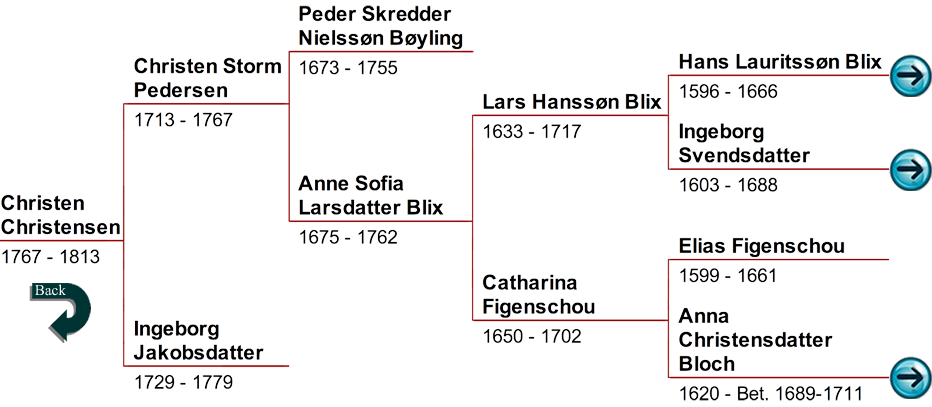 |
We wish to thank Åse for sharing the research done by genealogist Kaare Hasselberge, with us. Two forward arrows are disabled at this time. |
At 32 years old, on July 19, 1745, Christen was betrothed to 74 year old, twice widowed Berit Nilsdatter. They were married three months later on October 18, 1745, in Bodø. He took over her farm, that she inherited and ran, in South Hærnes. They never had children and were married for 18 years, until Berit died on October 2, 1763, at the age of 92. Apparently while still married to Berit, he had an affair with Marit Jonsdotter, who bore him a daughter two months after his wife died. They named the child Beret, after his deceased wife and baptized her on December 11, 1763. It is believed that this child died very young. Seven months later on July 28, 1764, 51 year-old Christen married 35 year-old Ingeborg Jakobsdatter, who was believed to be a widow with a child. Both were recorded as being from Hernes. The marriage was a short one, less than three years, as a little over a month before their third child was born, Christen died on May 24, 1767, at the age of 54. His death record stated he was 55 ½ and from Hernes. (Mouse over image below.) |
| ~< Back to Chart >~ |
Ingeborg Jakobsdatter’s ancestry is unknown. It is believed she was born about 1729. In the Norway, Baptisms, 1634-1927, there is a record for a baptism on November 1, 1757, for a Karen Christiansdatter, whose parents were Christian Villadsen and Ingebor Jacobsdr, in Bodø, Nordland County, Norway. This couple married after the child was born on April 4, 1758, and both were from Hernes. This could very well be our Ingeborg.
Two years later on July 17, 1769, Ingeborg married Jon Michalsen, both listed as being from Hernes. A year later on September 29, 1770, a son Hans was baptized to father Jon Michalsen of Hernes. Unfortunately, a mother is not listed. Ingerborg was about 42 years old at that time, so they may have had other children. Ingebor Jacobsdatter of Hernes died at age 49 on July 25, 1779. |
| ~< Back to Chart >~ |
Peder Skredder Nielssøn Bøyling’s ancestry is unknown. It is believed he was born about 1673, and was possibly from Denmark. On the known baptism records for four of his children, he is listed as Peder Skredder. His death record lists him as Peder Nielsen Boÿling of Hernes, which is probably his legal name, but we decided to include all of his recorded names here. It is believed Peder came to Norway about 1700.He married Anne Sofia Larsdatter Blix, probably soon after he arrived, and they had six children. He was a tailor and a cottager on the farm Adriangården in Lower-Rønvik in Bodø, Nordland In 1745, Peder and Anne Sofia probably moved in with or near their son, ancestor Christen, in Hernes, as that is where he died at the age of 82 on December 21, 1755. (Mouse over image.) |
| ~<^>~ |
Anne Sofia Larsdatter BIix was born about 1675 in Bodø, Nordland County, Norway, the eldest of five known children of Lars Hanssøn Blix and Catharina Figenschou. Anne Sofia Blix lived seven more years at Hernes after her husband died. Her death record dated January 31, 1762, seems to state that Ane Sophia Blix of Hernes was 98 years-old, but this cannot be correct. It is more likely she was 88 years-old when she died. (Mouse over image right.) |
| ~< Back to Chart >~ |
Lars Hanssøn Blix was born about 1633, the sixth of ten children born to Hans Lauritssøn Blix and Ingeborg Svendsdatter. In 1666, Lars’ older brother, Hans was acting as pastor in his recently deceased father’s church. He also owned his father’s farm in Ytre (Outer)-Hærnes. Because of a long running feud between his father and the local magistrate, once his father was dead, the magistrate got the king to appoint his own candidate to the church and transferred Hans to another parish. Hans could not run his farm from afar, so he let his next oldest brother, ancestor Lars, take over the farm as a tenant. It was probably around this time when Lars married Catharina Figenschou. They had at least five children together.
With all of his good fortune, Lars ended up in deep debt. He lost everything and went to live with one of his sister’s families in Steigenberger in Nordland County. Both Ingeborg, who was already dead, and Alhet, whose husband had died years ago, lived in Steigen. It is not certain which family he lived with, but it seems logical that he would go to the youngest sister Alhet’s family. Lars Hanssøn Blix died in March of 1717, in Steigen. The record of his death is difficult to read and translate, but it seems to mention both Alhet’s name and Ingeborg’s daughter, Maren Hartvigsdatter’s, name in it. This could mean that they all lived together! |
| ~<^>~ |
Catharina Figenschou is believed by most researchers to be the first wife of Lars Hanssøn Blix. She was one of six children, probably born in Bergen, Hordaland County, Norway, in about 1650, to Anna Christendatter Bloch and her husband, artist Elias Figenschou. She married Lars Hanssøn Blix about 1667, and they had at least five children together, all born in Bodø – ancestor Anne Sofia; Ole Larsson born about 1683, whose estate was probated on May 31, 1724; Lars Lauritssøn born about 1687, and died in 1760; Anna Larsdatter born about 1689, married Niels Jacobsen Schanche, and lived in Bodø, Nordland County in 1749; and Barbro Larsdatter born about 1697, and died in Bodø on March 3, 1755. All their birth dates are uncertain. Catharina Figenschou died about 1702, probably in Bodø. Unfortunately, many records for this time period are not accessible or do not exist, so dates and exact names are uncertain. |
| ~< Back to Chart >~ |
Hans Lauritssøn Blix was born about 1596 in Rödön in Jämtland, which was then in Norway, but under Danish rule, and is now in Sweden. On July 2, 1617, he enrolled at the University of Copenhagen to continue his education. Only two years later, he received a royal letter, dated March 10, 1619, which gave him permission to be chaplain with his father in Rödön. It is believed that because his father had been faithful to Norway during the war, the process was expedited. In 1622, Hans was 26 years old, and was appointed parish priest in Bodø, one of the Northland’s largest parishes, which supports the assumption that his family was still in good favor with the King. This was about the time he married Ingeborg Svendsdatter, and they had ten children together over the years. Soon after Hans arrived in Bodø, he began to create a social and economic position of power for himself that no cleric in Salten had since the Reformation. He was one of the wealthiest and most prominent clergymen in Nordland, in the 1600s. He obtained a large amount of property including farms; ran a large fishing and shipping trade; owned several sloops; owned at least 14 warehouses; and several houses including boathouses. In 1652 he paid taxes in Væran, Skjerstad, and in Arnøya in Gildeskål. Later he also owned land in Inner-Hærnes. Hans donated, to the Bodin Church, a brass chandelier with eight arms, which is in the church today. He became dean of Salten in 1641. It seems that the people either feared or adored him, because they supported his efforts, and he had little opposition to his industrious ways. Those who did question his dealings wound up leaving the area, until 1646. This is when Preben von Ahnen moved to From May to July of 1654, Preben got the Commission to decide that Hans had to move his boathouses. Thus Hans found himself in a very difficult situation, for the narrow beach belt that belonged to the vicarage, was not a proper landing site. Hans tried to achieve a friendly settlement, but his wealth ended the matter. He paid at least $1,800 dollars in the form of a loan, to secure that the boathouses would stay where they were. This feud did not stop, even at Hans’ death on June 27, 1666. Hans’ son Hans Hanssen Blix was, for a number of years, his father's curate, and was expected to take his father’s place in the church. On September 22, 1666, Preben got the king to confirm the appointment of Preben’s own candidate, who was married to a daughter of a man who would benefit Preben’s own good. Hans’ portrait with the words, “Natus 1596. Ætalus 58 Denatus 1666” hangs in Bodin Church next to his wife’s portrait. In the churchyard is a beautifully finished and very well preserved gravestone. The tomb plate (Mouse over image right.) is now walled in the side of the church besides the altarpiece and reads “HER HVILER HER HANS LAURITSON BLIX. SOGNEHERRE TIL BAADE GIELD OCH PROWIST OFFVER SALTENS LEHN FØDT OCH BAAREN ANNO 1596 OCH I HERREN HENSOFFVET SALIGEN ANNO 1666.” |
| ~<^>~ |
Ingeborg Svendsdatter was born in 1603, most likely in Trondheim, Sor-Trondelag County, Norway. Ingeborg married Hans Lauritssøn Blix, probably about 1624 and they had ten children together, all born in Bodø, Nordland County, Norway, – On August 19, 1666, two months after her husband died, she founded an endowment for the poor and destitute in the parish. The money was to go into the parish poor box instead of to the interest of the church organization in Bergen. Unfortunately this fund is said to have been quickly exhausted. It is said that she did not give the new priestly family a particularly warm reception. Probably because her son Hans, who was groomed to take over the Bodin Church, was overlooked and transferred to another parish. She was then moved to Alstad, where she was to lived out her life as a widow, but she kept the right to use Kvalvåg and other lands including Støver on Innstranda. Some say she lived in Kvalnes (Kvalvikfjellet?). In 1670, she donated a magnificent altarpiece, (click on image right to enlarge in a new window/tab) which is still in the Bodin Church. On it, both her and her husband's names are clearly written, so that the new pastor and the church should not forget who had been in charge of the vicarage for 40 years! Ingeborg Svendsdatter died in 1688, in the Bodø Parish. Her portrait, which was painted in 1654, by Johan Hansen Contrafeyer, hangs near her husband’s portrait in the Bodin Church with the inscription Ætalus 51. |
| ~< Back to Chart >~ |
Elias Figenschou was born about 1600, probably the eldest child of parents Hans Mathiasen Fügenschuh and Katharina, surname unknown. Some researchers say his father’s name was Christopher, and he was known as Elias Christopher from Helgeland who was in Bergen on August 14, 1632. Unfortunately, we may never know his ancestry. Where Elias was born is also a mystery. Of those who say he is the son of Hans, there are two opinions: some say it was on the Fügenschuh’s horse breeding estate in Bavaria, in the small town of Allgäu in Hindelang; others say it was in Copenhagen, Denmark. The reason for the uncertainty is because the estate was sold just about the time he was born, and the family moved to Copenhagen. It is not known if Elias was born before or after the move. Elias was educated in the Netherlands and came to Bergen as an adult, some say in the early 1630’s, where he worked as an artist.
Elias Figenschou died about 1661. No one knows where or exactly when he died and is buried. |
| ~<^>~ |
Anna Christensdatter Bloch was born about 1620, on a Horsdal farm in the Gildeskål parish and Salten shire, in Nordland County, Norway. (Gildeskål parish is now in the Bodø deanery.) Anne was probably the eldest of five known children born to Berete (Birgitte) Andersdatter Benkestokand her husband Christen Jenssøn Bloch, the bailiff of Salten. In about 1645 she married artist Elias Hansen Figenschou and they had six children — ancestor Catharina; Jeremiah, born in Bergen on December 1, 1655; Catharina; Ermegard; Hans; Mathias; and Elias. The dates and places of birth of the children, are mostly unknown. Some researchers say ancestor Catharina’s name was Kristina. In 1661, her husband Elias was dead, her mother and father were dead, and she was left alone with six children. Although she was due an inheritance from her parents, her stepfather and guardian had refused to give her what was left to her. On June 22, 1661, Anna wrote to the king to ask for assistance to get possession of her inheritance from her father, who died 24 years earlier: “min mig ongefehr for 24 aar siden tilfalden fædrene Arff.” In Kristian Bloch’s article about Elias Figenschou, in the Norwegian Family History Magazine, she states (translated) “. . .it appears that Anna Christensdatter Bloch was the owner of . . . the farm Horsdal in Gildeskål, and this farm was inherited from her father. She later disposed of it to the brother-in-law, . . . in Salten, Michel Olufssøn Storm, who was married to her sister Sophia Christensdtr. Bloch.” Her second husband, was Otte Ottesen (some say his surname was Lorck), a sailor (first-mate) who was born in Trondheim, Sør-Trøndelag County, about 1617, and at the time of the marriage, was in Nordeidet on Karsøy Island in Troms County. Researchers differ on the number of children that they had. It seems possible that they had at least three children – Anne, born about 1665, whom all researchers agree on; Johan, born about 1667; and Hans, born about 1668, after his father’s death. Both Johan and Hans can be found on the 1701/2 census for the Tromsöe parish Helgöe location, but Johan is listed as being a 30 year old Impoverished cottager. Johan had to be at least 35 years old. Hans’ age is only one year off. Anna was again left a widow, but this time without small children. Anna married husband three, Laurits Hansen Løfberg, soon after her second husband died. He was about twelve years younger than she was, and became bailiff in Tromsø shortly after the marriage. It is not known if they had any children, but she being in her late 40’s makes it easy to surmise they didn’t. It seems that her new husband was dismissed as bailiff in 1690, and was demoted to acting as the new bailiff’s clerk. Some researchers say that Anna Christendatter Bloch died in the then large fishing village of Helgøy, on the now uninhabited island of Helgøya, before 1711. (The island of Helgøya is now an abandoned village of picturesque wooden houses with a historic church that is used on special occasions. The houses are sometimes still used, but only as vacation homes.) Other researchers say Anna died about 1689, in the village of Nordeidet, which is in the island municipality of Karlsøy, in Troms County. This seems plausible as in Kristian Bloch’s article mentioned above, she states that Anna Christendatter Bloch’s name is not found in any records after 1689. |
| ~< Back to Chart >~ |
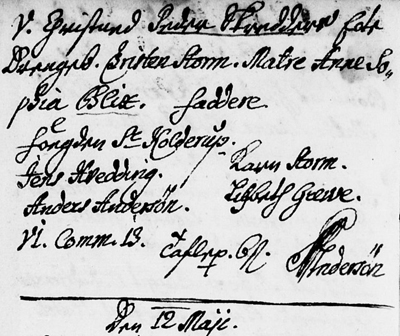 Christen Storm Pedersen was baptized on May 7, 1713, in Bodø, Nordland County, Norway. The Norway, Baptisms, 1634-1927 collection lists his parents as Peder Skredders and Anne Sophia Blix. (Mouse over image right.) He had at least three brothers and two or three sisters.
Christen Storm Pedersen was baptized on May 7, 1713, in Bodø, Nordland County, Norway. The Norway, Baptisms, 1634-1927 collection lists his parents as Peder Skredders and Anne Sophia Blix. (Mouse over image right.) He had at least three brothers and two or three sisters. The inventory of his estate dated July 13, 1767, proved that he died a wealthy man. Items included were engraved cups, silver spoons, a copper kettle, wood stove, tin, ore, iron, and brass items, a snuff box, cattle, a sail boat with a variety of fishing equipment, two houses, a boathouse, a sea house, the corn and rye crops and two books-one Bible and one Postill. His clothing, which was considered too fine for a farmer, included many items , some made of wool, with a total of 72 silver buttons.
The inventory of his estate dated July 13, 1767, proved that he died a wealthy man. Items included were engraved cups, silver spoons, a copper kettle, wood stove, tin, ore, iron, and brass items, a snuff box, cattle, a sail boat with a variety of fishing equipment, two houses, a boathouse, a sea house, the corn and rye crops and two books-one Bible and one Postill. His clothing, which was considered too fine for a farmer, included many items , some made of wool, with a total of 72 silver buttons. On July 28, 1764, at Hernes, Ingeborg married Christen Storm Pedersen. (Mouse over image right.) They had three children together, all baptized at Hernes on the dates shown– Ane Birgitta, who was baptized a month after her parents wedding, on August 26, 1764; Jacob Normann on October 13, 1765; and ancestor Christen, baptized after his father’s death. Ingeborg was left a wealthy woman with three small children.
On July 28, 1764, at Hernes, Ingeborg married Christen Storm Pedersen. (Mouse over image right.) They had three children together, all baptized at Hernes on the dates shown– Ane Birgitta, who was baptized a month after her parents wedding, on August 26, 1764; Jacob Normann on October 13, 1765; and ancestor Christen, baptized after his father’s death. Ingeborg was left a wealthy woman with three small children. County, Norway, from 1708 to 1719. It is said that in 1719, he took over the farm from Jens Vellasson and ran it until 1745. He hired workers to do the manual labor on the farm, while he continued his trade as a tailor. His reputation as a tailor grew and his business flourished. It should be noted that the Norwegian word for tailor is skredder. Being that he was highly regarded as a tailor, the record keepers may have simply recorded his occupation as his surname, instead of using his full legal name.
County, Norway, from 1708 to 1719. It is said that in 1719, he took over the farm from Jens Vellasson and ran it until 1745. He hired workers to do the manual labor on the farm, while he continued his trade as a tailor. His reputation as a tailor grew and his business flourished. It should be noted that the Norwegian word for tailor is skredder. Being that he was highly regarded as a tailor, the record keepers may have simply recorded his occupation as his surname, instead of using his full legal name. Anne’s mother died probably just before she married Peder and her father remarried. Peder and Anne had six children, all born in Bodø – Hans, born about 1704; ancestor Christen Storm; Elias Figenskow, who was named after her mother’s father and baptized on August 30, 1716; Zacharias Mandrop, baptized on October 16, 1718; and two daughters, Engeborg Sofia, who was named after her great-grandmother; and Kierstina Katrina. Unfortunately there isn’t a baptism record for either of the daughter’s names, just one for a Female born to Peder Skredder and Anna Sophia, on August 3, 1721. So we don’t know which daughter was baptized on this date. It should be noted that on daughter Kierstina’s marriage record, her surname is listed as Bøyling.
Anne’s mother died probably just before she married Peder and her father remarried. Peder and Anne had six children, all born in Bodø – Hans, born about 1704; ancestor Christen Storm; Elias Figenskow, who was named after her mother’s father and baptized on August 30, 1716; Zacharias Mandrop, baptized on October 16, 1718; and two daughters, Engeborg Sofia, who was named after her great-grandmother; and Kierstina Katrina. Unfortunately there isn’t a baptism record for either of the daughter’s names, just one for a Female born to Peder Skredder and Anna Sophia, on August 3, 1721. So we don’t know which daughter was baptized on this date. It should be noted that on daughter Kierstina’s marriage record, her surname is listed as Bøyling.
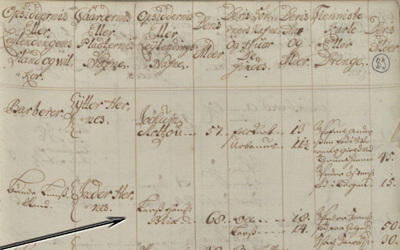
 Hans was one of three known children born to Laurits Magnusson Blix and Gulloug Mogensdatter. He probably studied theology with his father, as a young boy, and was Rector of Viborg Grammar School from 1605 to 1606, at a young age. From 1608 to 1613, he was præceptor (master) for the young nobleman Gregers Krabbe, who later became Governor-General of Norway, and with him visited several universities. In 1613, he was back home to his family.
Hans was one of three known children born to Laurits Magnusson Blix and Gulloug Mogensdatter. He probably studied theology with his father, as a young boy, and was Rector of Viborg Grammar School from 1605 to 1606, at a young age. From 1608 to 1613, he was præceptor (master) for the young nobleman Gregers Krabbe, who later became Governor-General of Norway, and with him visited several universities. In 1613, he was back home to his family.
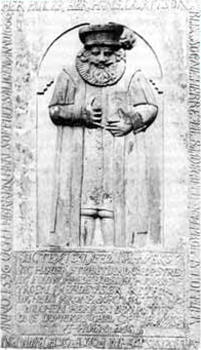 Bodø, as the new lord of the Northlands, living next door to Hans. At first, Preben made no attempt to challenge the parish priest's economic power position, but as time went on, things changed. It started over the stream that was the boundary between their two properties. Both saw the other as a competing center of power, and when in 1650, Preben forced through his choice of a new priest in Bodø, it was clear they were not on the same side.
Bodø, as the new lord of the Northlands, living next door to Hans. At first, Preben made no attempt to challenge the parish priest's economic power position, but as time went on, things changed. It started over the stream that was the boundary between their two properties. Both saw the other as a competing center of power, and when in 1650, Preben forced through his choice of a new priest in Bodø, it was clear they were not on the same side.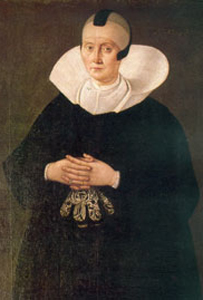 She was one of four known children of Svend Andersen, bailiff of Trondheim and Maren Hansdatter. Svein Tore Dahl, in his book, The Clergy of Northern Norway and Central Norway in the period 1536-1700, states that the proof that she is their daughter lies in a document dated August 17, 1657, in which Svend Andersen's brother, Nils Ebbesen, gives a farm in Trondheim to his brother’s children. This document is signed by “Hr . Mogens Hansen Blix on their parents' behalf.
She was one of four known children of Svend Andersen, bailiff of Trondheim and Maren Hansdatter. Svein Tore Dahl, in his book, The Clergy of Northern Norway and Central Norway in the period 1536-1700, states that the proof that she is their daughter lies in a document dated August 17, 1657, in which Svend Andersen's brother, Nils Ebbesen, gives a farm in Trondheim to his brother’s children. This document is signed by “Hr . Mogens Hansen Blix on their parents' behalf.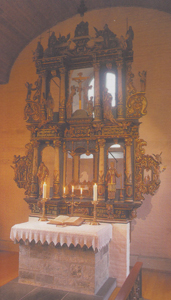
 In Norwegian art history, he is considered the first Baroque painter, and is known as the most significant representative of the Netherlands-influenced Baroque painting in Norway. His first signed work, done in Norway, dates to 1641. According to the tax records of 1645, he settled in the artists' quarter of Bergen, near the church. This is just about the time he married Anna Christendatter Bloch. She was from Horsdal, which is about 9 km north of Innvik, where Elias painted portraits of the church minister and his wife in 1644. Elias probably met Anna at this time. They had six children together. In 1650, he painted the portraits of his wife’s brother, Jens Christian Bloch, pastor of Hadsel church and and his sister-in-law, Maren Hans Blix, the daughter of ancestors Hans Lauritssøn Blix and Ingeborg Svendsdatter. In 1652 he was referred to as Kontrefejeren in Bergen, Elijah Fugelschoug. In 1656, he painted the Halsnøy Monastery, pictured right, which is considered to be the oldest Norwegian landscape painting, and hangs on the wall in Skoklosters castle outside Stockholm, Sweden. (Mouse over image for details.)
In Norwegian art history, he is considered the first Baroque painter, and is known as the most significant representative of the Netherlands-influenced Baroque painting in Norway. His first signed work, done in Norway, dates to 1641. According to the tax records of 1645, he settled in the artists' quarter of Bergen, near the church. This is just about the time he married Anna Christendatter Bloch. She was from Horsdal, which is about 9 km north of Innvik, where Elias painted portraits of the church minister and his wife in 1644. Elias probably met Anna at this time. They had six children together. In 1650, he painted the portraits of his wife’s brother, Jens Christian Bloch, pastor of Hadsel church and and his sister-in-law, Maren Hans Blix, the daughter of ancestors Hans Lauritssøn Blix and Ingeborg Svendsdatter. In 1652 he was referred to as Kontrefejeren in Bergen, Elijah Fugelschoug. In 1656, he painted the Halsnøy Monastery, pictured right, which is considered to be the oldest Norwegian landscape painting, and hangs on the wall in Skoklosters castle outside Stockholm, Sweden. (Mouse over image for details.)